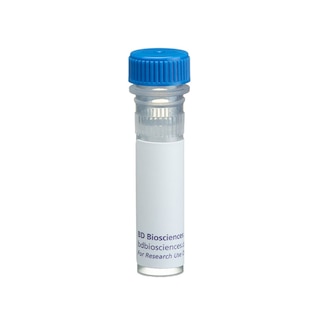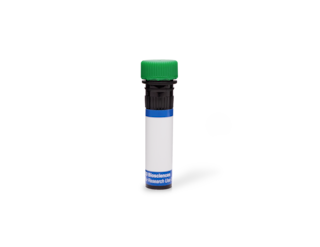-
Reagents
- Flow Cytometry Reagents
-
Western Blotting and Molecular Reagents
- Immunoassay Reagents
-
Single-Cell Multiomics Reagents
- BD® OMICS-Guard Sample Preservation Buffer
- BD® AbSeq Assay
- BD® Single-Cell Multiplexing Kit
- BD Rhapsody™ ATAC-Seq Assays
- BD Rhapsody™ Whole Transcriptome Analysis (WTA) Amplification Kit
- BD Rhapsody™ TCR/BCR Next Multiomic Assays
- BD Rhapsody™ Targeted mRNA Kits
- BD Rhapsody™ Accessory Kits
- BD® OMICS-One Protein Panels
-
Functional Assays
-
Microscopy and Imaging Reagents
-
Cell Preparation and Separation Reagents
Old Browser
This page has been recently translated and is available in French now.
Looks like you're visiting us from {countryName}.
Would you like to stay on the current location site or be switched to your location?
BD Transduction Laboratories™ Purified Mouse Anti-Human PKR
Clone 13/PKR (RUO)





Western blot analysis of PKR on a A431 cell lysate (Human epithelial carcinoma; ATCC CRL-1555). Lane 1: 1:1000, lane 2: 1:2000, lane 3: 1:4000 dilution of the mouse anti- human PKR antibody.

Immunofluorescence staining of human endothelial cells.




Regulatory Status Legend
Any use of products other than the permitted use without the express written authorization of Becton, Dickinson and Company is strictly prohibited.
Preparation And Storage
Recommended Assay Procedures
Western blot: Please refer to http://www.bdbiosciences.com/pharmingen/protocols/Western_Blotting.shtml
Product Notices
- Since applications vary, each investigator should titrate the reagent to obtain optimal results.
- Please refer to www.bdbiosciences.com/us/s/resources for technical protocols.
- Source of all serum proteins is from USDA inspected abattoirs located in the United States.
- Caution: Sodium azide yields highly toxic hydrazoic acid under acidic conditions. Dilute azide compounds in running water before discarding to avoid accumulation of potentially explosive deposits in plumbing.
Companion Products


Double stranded RNA (dsRNA) generated by most viruses during the infectious cycle is a potent stimulator of interferons. Interferons bind to cell surface receptors and stimulate the synthesis of several proteins that interfere with viral replication. One protein, 2'5'-oligo-adenylate synthetase, indirectly activates an endoribonuclease that degrades viral RNA. Another protein, p68 serine/threonine protein kinase (also known as PKR and TIK), is induced following interferon stimulation and activated by autophosphorylation in the presence of dsRNA. Upon activation, p68 phosphorylates the α subunit of the eukaryotic initiation factor 2 (eIF-2) resulting in inhibition of protein synthesis and, in turn, inhibition of viral replication. Evidence also suggests that p68 protein kinase inhibits proliferation and potentiates tumor suppressor function. In addition, p68 has been shown to phosphorylate Iκ-B, thus activating NF-κB which induces interferon-β gene transcription.
This antibody is routinely tested by western blot analysis. Other applications were tested at BD Biosciences Pharmingen during antibody development only or reported in the literature.
Development References (4)
-
Barber GN, Tomita J, Hovanessian AG, Meurs E, Katze MG. Functional expression and characterization of the interferon-induced double-stranded RNA activated P68 protein kinase from Escherichia coli. Biochemistry. 1991; 30(42):10356-10361. (Biology). View Reference
-
Feng GS, Chong K, Kumar A, Williams BR. Identification of double-stranded RNA-binding domains in the interferon-induced double-stranded RNA-activated p68 kinase. Proc Natl Acad Sci U S A. 1992; 89(12):5447-5451. (Biology). View Reference
-
Lee TG, Tomita J, Hovanessian AG, Katze MG. Characterization and regulation of the 58,000-dalton cellular inhibitor of the interferon-induced, dsRNA-activated protein kinase. J Biol Chem. 1992; 267(20):14238-14243. (Biology). View Reference
-
Meurs E, Chong K, Galabru J, et al. Molecular cloning and characterization of the human double-stranded RNA-activated protein kinase induced by interferon. Cell. 1990; 62(2):379-390. (Biology). View Reference
Please refer to Support Documents for Quality Certificates
Global - Refer to manufacturer's instructions for use and related User Manuals and Technical data sheets before using this products as described
Comparisons, where applicable, are made against older BD Technology, manual methods or are general performance claims. Comparisons are not made against non-BD technologies, unless otherwise noted.
Please refer to Support Documents for Quality Certificates
Global - Refer to manufacturer's instructions for use and related User Manuals and Technical data sheets before using this products as described
Comparisons, where applicable, are made against older BD Technology, manual methods or are general performance claims. Comparisons are not made against non-BD technologies, unless otherwise noted.
For Research Use Only. Not for use in diagnostic or therapeutic procedures.